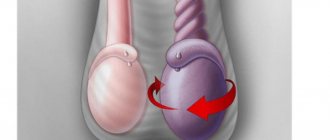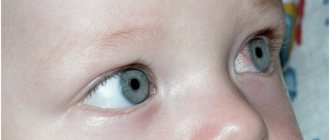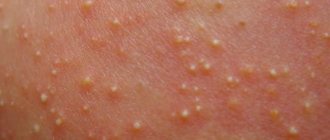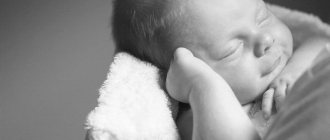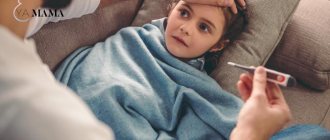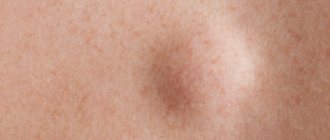One of the common topics among concerned parents is the different ears of a newborn. This issue is often discussed in various forums, pediatricians are addressed with this complaint, they leaf through a mountain of specialized literature and an endless number of Internet sites. And as a result - even greater anxiety.
But is this phenomenon worth such parental nerves and worries? That is why we will next talk about the features of ear development and hearing function in infants, and also find out the causes of ear asymmetry.
Why does a child have different ears?
At birth, infants often have different ears:
- by size, when one ear is larger than the other;
- protrusion;
- drawing of the ears;
- location.
Doctors classify the causes of different ears by type:
Congenital causes include the anatomical features of the formation of cartilage and bones of the ear system. Deformation of cartilage tissue can lead not only to macrotia - a disproportionate increase in the external auricle, but also to protruding ears. Also considered congenital is a defect when the upper cartilages of the auricle fold down, which creates the effect of drooping upper tips of the ears. These changes may be hereditary or related to the position of the fetus during the formation of the external ear.
Thickenings, tumors, scars, wrinkles on the ears are acquired defects.
This is important: Ears that are different in size at birth can spontaneously straighten out up to 6 years of age, while the child’s auricles are forming. This defect is not a pathology and does not require treatment.
Summary
Parents have different attitudes towards protruding ears in their children. Some people consider protruding ears to be a cute feature, while for others it is a problem that requires urgent elimination. Children's opinions also vary. Some don’t pay attention to their protruding ears, others are terribly embarrassed and suffer.
If you decide to correct the shape of your ears, then for up to six months this can be done conservatively, with the help of bandages and correctors. Later, with the help of otoplasty surgery, which is recommended for children before going to school.
Many parents are familiar with the situation when their child has an earache. At the same time, not all adults know how to help their baby get rid of excruciating pain. Note that ear diseases in children are a fairly common problem. Firstly, babies’ ears, due to the anatomical features of the auditory tube, are susceptible to all kinds of inflammation. Secondly, often the child’s painful condition worsens in the evening, when it is not possible to show it to a specialist.
Therefore, in our article today we will try to tell you how to care for a child’s hearing organs so that such problems do not arise. Let's also talk about how to cure otitis media and other common childhood ear diseases. We hope that our information will be useful to you.
In what cases is surgical treatment used?
If after 6 years the ears remain different in shape, but this factor does not bother the child in any way:
- ears don't hurt;
- hear well;
- no noise, itching or discharge.
This defect can be considered cosmetic. It requires surgery only if it causes psychological discomfort to its owner. When a child is laughed at, his ears are pulled, his peers call him names, then such a child is in constant stress, and this negatively affects his overall health. Then, after consultation with an otolaryngologist, you can resort to surgery to straighten the outer auricles. If this defect can somehow be covered with hair, a hat, etc., then the doctor will advise the parents to avoid surgery. But if they and the child are adamant and continue to demand surgical intervention, then in the absence of contraindications such an operation can be performed.
Contraindications may include:
- poor blood clotting;
- any diseases of different organs;
- diabetes;
- tumor or cyst formations and so on.
The doctor is obliged to warn you about possible complications or unpleasant consequences after surgery:
- bleeding;
- suppuration of sutures;
- inflammation of the cartilage, as a result of which wrinkles may remain on the auricle;
- the presence of scars and so on.
Small ears. Physiognomy. Character traits. Ways to reduce.
* Low intelligence. This quality prevents people with small ears from calming down the conflict between what is desired and what is actual.
Chinese physiognomy considers the ear to be the most important organ of the human body. A person’s character, destiny, especially childhood years, can be found out by carefully studying the size and shape of the ears. From the left ear you can determine the influence of the father and fate up to 7 years, and the right ear gives information about the mother and fate from 8 to 14 years.
The position of the ears is of great importance. The higher the ear, the greater the likelihood of achieving success in your career and personal life. If the upper border of the ear is located above the eyebrows, then this indicates high intelligence. At eye level - above average. Below eye level - below average, low.
Small ears, sometimes without lobes, are characteristic of Armenians, Turks (eastern and central parts of the country), Meskhetian Turks, Jews, Syrian-Palestinian Arabs (Syria, Palestine, Lebanon), some Western Iranian peoples (Lurs, Muslim Kurds, Bakhtiari , Talysh), Meskhi, Javakh.
Ways to reduce ears. Plastic surgery.
Our ears are primarily hearing organs. Their main function is sound detection. The funnel-shaped shape allows you to transform and concentrate sound waves. The protective function is to protect the inner and middle ear from dust and injury.
But ears also play an important role in aesthetic appearance. Teenagers with large protruding ears find it difficult to find a common language with their peers. The ridicule of classmates leads to a child becoming complex and withdrawn.
The solution in such a difficult situation is otoplasty. This operation will get rid of complexes in a couple of hours. It can not only make ears smaller, but also correct deformed and asymmetrical ears.
Is this feature dangerous?
Different ears are absolutely safe for hearing health. As a rule, this visual defect disappears by 5-6 years. It does not in any way affect the ear system itself, or the health of the organs, tissues, or cartilages of the complex auditory mechanism. Therefore, you can live peacefully with different ears. If this fact still confuses you, then you can:
- make an asymmetrical hairstyle that hides one ear;
- wear bandanas or headscarves;
- cover your ears with long hair.
We must remember that any operation is a direct surgical intervention in the body. It’s all the more offensive that in this case, it’s in a healthy body. Make this a plus for yourself - your zest. Or just be humorous about your ears. After all, the main thing is that they are healthy.
Emergency situations
There are such ear pains that you should immediately call an ambulance and not waste a minute on anything else.
You need to call emergency services if:
- the child is under one year old (this is especially true for newborns);
- the baby has a temperature above 39.0 degrees;
- The child started vomiting due to the high temperature, and there was leakage from the ear;
- if the child was bitten in the ear by an unknown insect and swelling developed;
- if, against the background of acute pain or without it, sudden deafness occurs;
- if the child, after complaining about the ears, lost consciousness or had convulsions.
Causes and types
Differences in the ears of infants can be manifested by the following morphological characteristics:
- Size.
- Position in relation to the head.
- Anatomical pattern on the ears.
- Symmetry.
- Form.
The causes of such changes in the ears of infants can be congenital, acquired developmental anomalies, as well as minor functional characteristics of each baby, which disappear over time.
Congenital developmental defects are disorders that arose during the prenatal period. At this time, the child’s body is just forming, and the formation of one or another organ system is often disrupted. The auricles normally consist of cartilage tissue, the formation of which, unfortunately, is also sometimes affected.
Among the birth defects, the following are distinguished:
- Macrotia. Excessive amount of cartilage in the ears, which makes them visually appear larger.
- Microtia. Insufficient development of ears (one or two). These ears are quite small, slightly flat or ingrown. This pathology often causes hearing loss.
- Prominent ears. Normally, the ears are located almost parallel to the head; with protruding ears, they are located at an angle. The larger the angle, the greater the so-called protrusion of the ear.
- Changes in the ear helix (tragus). In some cases, it is completely absent, as is the tubercle. Instead, rudimentary elements (those that are not needed for humans) can develop; they do not cause much discomfort.
- Change in the shape of the upper part of the cartilage. It may be bent downwards and slightly inwards.
- Anatomical changes in the earlobe. Double, fused, completely absent.
Of the listed deviations, only microtia is a consequence of occlusion of the auditory canal and leads to impaired auditory function. All other defects are cosmetic.
Acquired defects are considered: tumors, thickenings, scars, wrinkles that form on the ears.
Intrauterine pathologies of the formation of the inner ear
Congenital anomalies of the development of the inner part of the ear apparatus occur in the following forms:
- pathology of initial severity is expressed in the abnormal development of the organ of Corti and auditory cells. In this case, the auditory peripheral nerve may be affected. Tissue from the organ of Corti may be partially or completely absent. This pathology affects the membranous labyrinth to a limited extent;
- pathology of moderate severity , when diffuse changes in the development of the membranous labyrinth are expressed in the form of underdevelopment of the partitions between the scalae and whorls. In this case, the Reissner membrane may be absent. An expansion of the endolymphatic channel or its narrowing due to increased production of perilymphatic fluid may also be observed. The organ of Corti is present as a rudiment or completely absent. This pathology is often accompanied by atrophy of the auditory nerve;
- severe pathology in the form of a complete absence - aplasia - of the inner part of the ear apparatus. This developmental anomaly leads to deafness of this organ.
As a rule, intrauterine defects are not accompanied by changes in the middle and outer parts of this organ.
Loading.
Should I worry?
Of course, if differences are detected in the structure of a newborn’s ears, it is better to seek advice from a pediatrician so as not to miss the above-mentioned congenital developmental anomalies. If they are nevertheless detected, then it is worth finding out whether this in any way affects the child’s hearing and whether it causes discomfort. If not, then this should not be a cause for concern, since it will not affect the general condition of the baby in any way.
True developmental defects are quite rare, and in most cases there is nothing to worry about.
Different ears are considered a cosmetic defect. Usually it is not treated in any way and they try to cover it up with long hair, wearing bandanas, scarves or panama hats. In this case, girls find it a little easier to cope with such a problem.
However, due to such characteristics, children may suffer from serious conflicts in kindergarten and at school; they begin to be ashamed of their appearance, which brings psychological discomfort.
In such situations, parents ask a doctor to somehow correct the situation. Most often, defects can be corrected through surgery; it can only be performed after consultation with an otolaryngologist. In most cases, doctors advise avoiding surgical procedures, but the final word remains with the parents.
Before performing the operation, all contraindications should be taken into account:
- Poor blood clotting.
- Diabetes.
- Cyst or tumor formations.
The doctor must also warn about the presence of possible complications and consequences that may arise after the operation:
- Bleeding.
- Festering of the sutures.
- Inflammation of the cartilage, which provokes the formation of wrinkles on the auricle.
- Scarring.
Different shapes and sizes of ears are absolutely safe for the normal functioning of the auditory mechanism and do not have any effect on the ear system or the health of tissues and cartilage. This visual defect most often disappears by 6 years.
Otoplasty
First, let us note that there are a lot of lop-eared children in the world, and they live well with this feature. For some, with age, the angle of deviation of the ears decreases and the protruding ears disappear. However, if it interferes with the child’s normal life, then surgery can be performed.
Surgical correction of the conchae is called otoplasty and is usually performed on children as young as six years of age. It is done in a plastic surgery clinic or in a children's hospital with a referral from a doctor.
This plastic surgery is one of the easiest in terms of technology and postoperative period.
Methods
Currently, there are more than two hundred methods of otoplasty. The most common of them are:
- traditional method. This is a common operation performed with a scalpel and other surgical instruments. For children under twelve years of age, otoplasty is performed under general anesthesia, after that - under local anesthesia. During the operation, the surgeon changes the shape of the cartilage and applies a special bandage. It should not be removed for several days to prevent deformation of the ears;
- laser method. Unlike traditional otoplasty, the operation is performed with a laser “scalpel”. This allows you to reduce the amount of blood (the vessels are immediately sealed) and disinfect the operated tissue.
Contraindications
Surgical correction of protruding ears is an operation. And, of course, it has some contraindications:
- HIV, syphilis, hepatitis B;
- period of infectious diseases - ARVI, influenza and others;
- skin problems in the ear area;
- diabetes mellitus and thyroid diseases;
- bleeding disorders;
- oncological diseases;
- acute phases of chronic diseases.
Rehabilitation and complications
The postoperative period of otoplasty is usually tolerated by children normally. The baby will take analgesics for the first couple of days after surgery. The doctor will also prescribe wearing a pressure bandage for three to seven days. For three weeks it is recommended to wear it at night.
Parents should lubricate the seams on their ears with products prescribed by the doctor. The suture material is removed after ten to fourteen days. After the operation, the ears should not be exposed to physical, thermal or ultraviolet effects for two months.
As for complications of otoplasty, their likelihood is extremely low if all the doctor’s instructions are followed. However, sometimes they happen. For example:
- suppuration If you notice signs of suppuration in the operated ears, inform your doctor immediately. Mild suppuration is cured in a couple of days;
- colloid scars. They may occur due to the characteristics of the child’s skin;
- discharge of the conchae of the ears. If you do not take care of your child's operated ears, a repeat operation may be required.
Why does a child have different ears?
One of the common topics among concerned parents is the different ears of a newborn. This issue is often discussed in various forums, pediatricians are addressed with this complaint, they leaf through a mountain of specialized literature and an endless number of Internet sites. And as a result - even greater anxiety.
But is this phenomenon worth such parental nerves and worries? That is why we will next talk about the features of ear development and hearing function in infants, and also find out the causes of ear asymmetry.
Hearing in a newborn: stages of development
Newborn babies do not have very well developed vision, but their hearing is excellent . While still in the womb, babies hear many different sounds: the beating of mother’s heart, her voice, the noise of the outside world. He even begins to react to most sounds: he may flinch from a sharp sound and turn his head in the direction of the noise.
Reference. By the time of birth, the child's basic hearing apparatus is already fully formed.
At birth, the outside world with all its sound wealth falls on the newly born little man. This activates his hearing function.
From this moment on, hearing will largely determine the development of the brain activity of a new person, initially stimulating certain skills (rolling over, sitting, crawling), and later speech and intellectual abilities.
Hearing development in babies goes through the following stages of formation:
- 1 month of life – the final formation of auditory function. The child begins to listen to the conversation and freezes if he hears a familiar voice. From an extraneous loud sound - he will flinch;
- 3 months – hearing and speech are already developed so much that the child can not only respond to his mother’s voice, but also “answer” her by babbling. But don’t rush to read fairy tales and poems to your baby - the baby is not yet able to concentrate on this;
- 5-6 months - children at this age respond to their name, turn their heads towards the sound, and listen. Loud, sudden noises can frighten little ones so much that they may burst into tears. And if you play with them, they will laugh;
- 6 months - 1 year - children begin to respond to sounds of varying intensities, easily recognizing where they come from. They hear and understand the voices of their parents. At the same time, the feedback is the children pronouncing an increasing number of words and accompanying them with various gestures.
Going through these stages of formation, hearing in children contributes to the development of speech ability. These two functions are closely interrelated . And if parents notice any deviations from the norm in the development of auditory function in their baby, rehabilitation must begin immediately.
In this regard the age of 3 is critical , since later it will be very difficult to teach a child with hearing loss to understand sounds and understand speech.
Having examined the features of hearing development in newborns, let's move on to the question of why a child has different ears.
Why does a child have different ear shapes?
First, perhaps, it is worth reassuring the parents. Many experts do not advise worrying about this at all, since this phenomenon occurs quite often in children.
That's all: ears of different shapes, different sizes, one ear is protruding, and the other is normal - a phenomenon that simply disappears with age.
The ears become the same, but if by the age of 5 the ears have not “evened out”, then you can undergo a cosmetic procedure if this difference is so embarrassing.
To prove the above, here are the comments of several mothers on forums who have experienced these problems:
Marina : “Mommies, don’t worry and don’t sound the alarm ahead of time. When we noticed a difference in the size of our baby’s ears (she was 4 months old at the time), we immediately rushed to the doctor. He examined and felt our ears and said that everything would be fine. And yes, we are now 2 years old and our ears are the same!”
Anna : “I experienced this problem myself. As a child, I had different ears: one was normal, and the other was slightly curved and protruding. I was little and didn’t really understand this, but when I started to grow up, the problem disappeared by itself. Now she is the mother of two children: her daughter has the same ears, but her son got one ear from his mother, and the other from his father.”
It’s a completely different matter if the baby has different ears and this causes him discomfort . The ear can fold during sleep, after which it hurts. The baby can constantly tug and rub and comb it.
The causes of such defects can be either congenital or acquired. The following pathologies can be classified as congenital defects of the concha:
- Macrotia is an excessive growth of cartilage tissue, which affects the proportional formation of the ear, making it large.
- Microtia is a partial formation of the ear shell (small, flat or ingrown ears).
- Prominent ears - the position of the ear in relation to the head is not parallel, but at an angle. The greater the angle, the more the ear protrudes.
- Changes in the shape of the ear curl - the curl and tubercle on the auricle may be absent, rudimentary formations may form on it.
- The top of the cartilage may be folded inward and downward.
- Violations of the anatomical shape of the earlobe - double lobe, fused or its complete absence.
While almost every deviation is predominantly cosmetic, microtia can be associated with occlusion of the auditory canal, which leads to impaired auditory function.
Reference . Each defect can be either unilateral or bilateral.
The acquired type of ear concha defects is caused by the following phenomena:
- ear injuries;
- burns;
- influence of chemicals;
- poorly performed surgical interventions;
- ear diseases.
Keloid scar is an acquired form of ear deformation that occurs most often. The nature of its appearance and formation is varied. It looks like a growth on the skin in the area of the earlobe or the entire ear.
